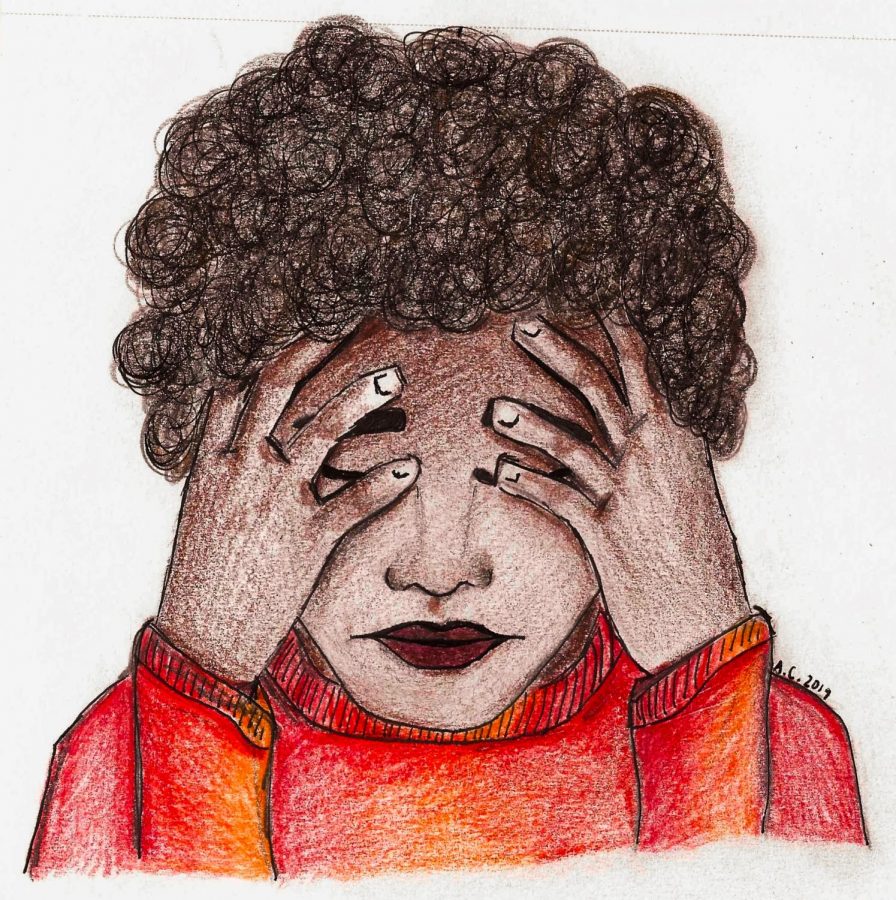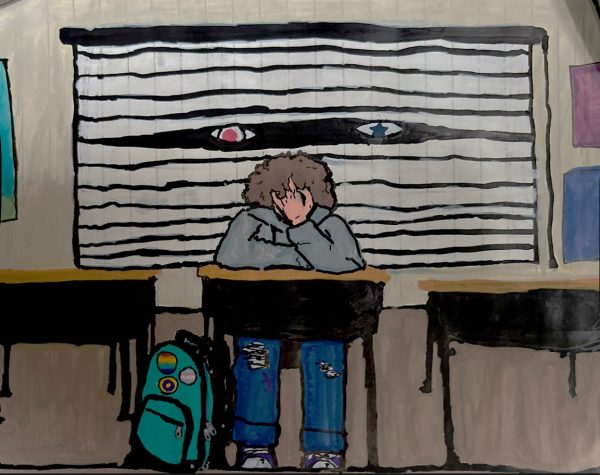Same School, Different Levels
Facing the Beachwood Achievement Gap
In 2017, white students averaged 24.8 on the ACT while African American students received an average score of 18.4.
Beachwood City Schools is a thriving and diverse school district home to a population of over 1,500 students.
The district is ranked #6 in Ohio, according to the most recent school report card data. BHS earned four A’s and two B’s on the state’s indicators.
72% of BHS students took one or more AP class last year. However, of the 264 students who are enrolled in one or more AP classes this year, only 25 of those are African American.
Over the years, BHS has held many events about the value of diversity and allowing minority voices to be heard.
However, for a community that values diversity, why is there not more push for an equal playing field?
What is An Achievement Gap?
An achievement gap is defined as a consistent disparity in academic achievement between minorities, other disadvantaged students and their white counterparts.
A Disparity in Test Scores
Achievement gaps are displayed in many ways in schools across the United States. One place it is clearly visible is on standardized tests (AIR, SAT and ACT).
The No Child Left Behind Act of 2002 was designed to increase American competitiveness in academics and was intended to address the achievement gap by increasing accountability in public schools through standardized tests. While NCLB had a significant impact on schools, it did not solve the achievement gap.
Many critics argue that NCLB did more harm than good. If public schools did not perform up to par with federal standards, they would lose funding. They could also be subject to state interventions which could lead a school to be shut down and students being sent to a better performing school.
In 2015, NCLB was replaced with the Every Student Succeeds Act, which gave states more flexibility and provided struggling schools with grants instead of budget cuts.
A 2019 BHS graduate, whom we will call Dominic, initially got a 19 on his ACT. Dominic, who is African American, felt sad and blamed himself, despite the fact that his parents could not afford an ACT tutor, and Beachwood did not offer an ACT prep program at that time.
“I was scared to tell my friends what my score was,” he said. “Whenever someone asked me, I would say that I hadn’t taken it yet or I was going to retake it soon. It was hard feeling like the only person who got a 19 in the whole school.”
With the help of friends and a borrowed ACT book, he was able to boost his ACT grade to a 25 and was able to attend a college of his choice.
The average composite ACT score for Beachwood students is a 25. The ACT administrative record for Beachwood from March 2017 states that Caucasian students received a 24.8 on average while African American students fell behind with an 18.4.
While both African American and white BHS students performed well above the average for their subset that year, Beachwood’s 6.4 point difference shows a significant disparity.
Nationally, only 241,678 African American students took the ACT compared to 996,712 Caucasian students. The composite scores for African Americans are an average of 16.9, while white students receive an average of 22.2.
On ELA AIR tests, the Ohio Dept. of Education measures performance index by subgroup. The performance index for African American students is 95.2 compared to 110 set by Caucasian students as of 2019. On Math AIR tests, the performance index is 90.6 for African American compared to 112.4 for Caucasian students.
Social studies teacher Pam Ogilvy teaches Government, which is an AIR-tested class.
“I try to provide all of my students with the support they need in preparation,” Ogilvy said. “I don’t differentiate based on race for an already flawed state exam, but more from student to student.”
The American Institutes of Research’s 2017-2018 Annual Technical Report outlines the clear gap state wide between White and African American students in the Government portion of the Ohio AIR test. According to the graph, Caucasian students consistently outnumbered African American students in the “Proficient” category and above, but are underrepresented in basic and limited levels.
Disparate Enrollment in Honors & AP Curriculum
Beachwood offers a wide range of AP courses. This year 264 students are enrolled in at least one AP class. However, of that number, only 25 are African American.
Social studies teacher John Perse, who teaches AP US History and AP European History, acknowledged that there is a gap in terms of the number of minority students enrolled in APs, but he does not see a large achievement gap among those students.
“I don’t really see a major achievement gap in my AP courses. My minority students [overall] are good students,” Perse said. “…I’ve had some extraordinarily strong minority students and some weak minority students.”
“I think a major gap comes from students who…do well at their schools in [other school districts] and come [to Beachwood] and don’t do well here,” he added.
English teacher Casey Matthews, who teaches College Prep and Honors English for freshmen as well as African American Literature, emphasized the need for more African-American students in accelerated courses.
“I’ve been teaching Honors for five years, and the percentage of African American students in Honors English has consistently been lower than the percentage of African American students in the school,” Matthews said.
“24% of BHS students are African American, but only 7-8% of those students take my Honors English class,” she said.
Senior Abby Adams has noticed the low numbers of African American students in her accelerated courses.
“I only see about 5-6 black students in my classes per day,” she said. “Some teachers are very strict on the people of color in my class and either dumb things down unnecessarily like going over to them and asking them if they understand and some other things they would never do to me or anyone else in the class.”
“They’re also made the main talking point whenever race comes up during class,” she added.
Adams acknowledges discomfort whenever race or slavery is brought up in class.
“But I’m not supposed to be comfortable talking about those things,” she said. “When certain people get comfortable, they become ignorant and begin to say things they shouldn’t such as the n-word and jokes about tragic historical events involving minorities.”
Senior Nicklaus Buford-Hullum echoed the discomfort of talking about black history and the n-word.
“The only time it played a part was when the conversation went to racial discussions, like when we covered Huck Finn,” he said.
Hullum spoke sarcastically about another incident in his sophomore English class.
“It was the same way sophomore year there was a fun moment, only for me, when Mr. Butler asked in a discussion if it was ok for African Americans to say the n-word. The class was silent and I had to break the silence.”
However, he felt that he wasn’t treated any differently than his peers and had a positive experience.
“I never felt as though my opinion was being discarded or not considered into the conversation,” he said.
Abdul Elepele, class of 2019, believes it begins with the student.
“It’s mostly just that students have to be motivated and just push forward on what they learn,” he said. “[Students are deterred by] the impression that being a minority in an AP or Honors class will be awkward, which is not always the case.”
Discipline
The 2017-18 school report card listed BHS enrollment at 608. 377 of those students were Caucasian, 146 are African American, 55 are Asian, 6 are Hispanic, 1 is Hawaiian Native and 24 are mixed race.
According to public data published by Cleveland.com, the suspension rate for white students was four percent, while the suspension rate for African American students was over fourteen percent.
This ten percent difference could be detrimental to African American students.
Given these numbers, an African American student at BHS is 31% more likely to get suspended than a Caucasian student.
According to national data, “While 6% of all students received one or more out-of-school suspensions in the 2013-2014 school year, the percentage was 18% for African-American boys and 10% for African-American girls.”
Officer CJ Piro has made it his goal to prevent fights and make Beachwood safer.
“One of my goals is trying to stay connected to students and try to nip problems in the bud before they escalate,” he said. “I always try to touch base and check in on students and their parents frequently to make sure they’re okay and staying out of trouble.”
“I value students’ safety and their courage to come and talk with me,” he added.
Formerly, when a student was suspended from anywhere between 1-10 days, any assignments that they were to receive or tests they have to take are automatically put into Infinite Campus as zeroes.
According to Janet Rosenbaum, an epidemiologist at SUNY Downstate Medical Center, “Suspensions predict greater risk of arrest, conviction, probation and lower educational attainment.”
Considering that each quarter is around nine weeks, this means that in the most extreme cases, students lose up to two weeks of school time they can not get back, which leads to a dramatic GPA drop.
Under Ohio House Bill 318 enacted in Nov. 2018, there have been momentous changes to suspension and disciplinary action in schools all over the state. A school district is now required to allow students to complete classroom assignments to recuperate points lost during the suspension period. Also, schools are prohibited from issuing suspensions to students from kindergarten to third grade.
However, despite this new legislation, suspensions can still lead to damaging grade drops, which take a toll on students’ GPAs.
Individual 1 was suspended for ten days during his sophomore year prior to this new legislation for fighting, but appealed it to the board and had it reduced to seven days.
Even so, his first semester GPA was a 3.3 prior to the suspension, and after the suspension, his GPA dropped to 2.7.
Individual two, a former BHS sophomore, was suspended on two separate occasions during the 2018-2019 school year. His first semester GPA was a 3.0 but after these suspensions, it dropped down to a 2.3.
Individual 3, A BHS freshman last year, was suspended for 5 days during the 2018-2019 school year. His first semester GPA was a 3.4 but after the suspension, he went down to a 2.9.
Significant GPA drops like these can interfere with college applications and even make it more difficult to transfer to a different high school. According to PrepScholar, the national average GPA for African Americans is 2.7 while Caucasian GPA average is 3.1.
Students Moving Into the District
Beachwood is home to 11,953 citizens as of the 2010 census. A majority 9,240 of these citizens are white and 1,638 are black. In 2000, Beachwood was only 9.08% black compared to 86.5% white.
However, from 2000-2010, there was a 4.6% increase in Black residents. This increase of African American families leads to an increase in African American students. While this increase leads to more diversity for the school district, the transition into Beachwood can be demanding, especially when students come from schools with lower academic expectations.
Kendyn Wiggins, an African American junior, transferred into Beachwood during his 2017-2018 year from Benedictine. He describes the transition as rough.
“At Benedictine, I was doing really well, but when I came to Beachwood, the curriculum was very ahead of Benedictine’s,” he said. “So when I got here, I didn’t understand what was happening.”
“I never had any groups or mentors to help me transition and help me catch up on the curriculum, which is a main reason why I fell behind last year,” he added.
Nadia Hall transferred into Beachwood from Riverside High School during her 2018-2019 year and also found it difficult.
“I struggled with making friends and trying to fit in when I first moved here,” she said. “Beachwood is kind of cliquey, and people always make assumptions based off what others say, which makes it even harder.”
“Also, at Riverside, we learned math a certain way, but when I came to Beachwood, I had to relearn it another way, which set me back,” she added.
However, Kye Johnson came to Beachwood in 2016-2017 year from Garfield Heights and didn’t struggle that much at all.
“The education was pretty much the same,” he said. “The only real difficulty I had was science, but I haven’t been very good in that subject throughout my high school career.”
Guidance counselor Meghann Sullivan acknowledges problems. Several years ago, she and then-TV production teacher Kevin Houchins, who has now been promoted to director of Equity and Community Engagement, initiated a program to address the issue.
“During the 2017-2018 year, I helped plan and implement a new student group to support new students as they transition into Beachwood and need to learn ‘how to Beachwood,’ which can mean anything from understanding our schedule, Infinite Campus and Chromebooks, to meeting teachers in a less intimidating setting where they can ask questions without fear (whether real or perceived) of being judged by others,” Sullivan wrote in an email.
The Importance of a More Diverse Staff
A contributing factor in the achievement gap is the lack of diversity among staff and administrators. 89% of the school district’s teachers are white and 70.3% of those teachers are white females. There are no Hispanic teachers and only four Asian teachers in the whole district. 7.7% of Beachwood teachers are black.
The school board currently includes two white men, two white women and one Asian woman. There are currently no African American school board members.
According to a study published in 2017, one black teacher in elementary school can make a significant difference in the lives of low-income black boys, reducing their chances of dropping out by almost 40%.
Katheryn-Anne Barney, an African American social studies teacher hired last year to teach U.S. History and World Studies, has demonstrated the impact that an African American teacher can have.
Many African American students, especially African American males, visit Barney’s class daily to vent, destress, play dominoes, or just to get help on their homework.
“I just remember what was important to me at that age and how teachers made me feel important,” Barney said. “I’ve created an open door policy for students to come and talk to me about anything. I give them an outlet. I think it makes them feel wanted.”
Junior Ralph Herkley is grateful for Barney and acknowledges the lasting impact she has had on him.
“She’s like my mom,” he said, chuckling. “She puts me in check and keeps me on top of the things I need to do.”
“She’s the only teacher I’ve felt a connection to,” he added. “I go to her room almost every day and she always welcomes me with open arms.”
“I believe increased diversity among the staff would be beneficial to the school because it would help students better connect and feel comfortable coming to them with incidents or situations they can relate to,” he said.
Ogilvy agrees.
“Diversity elevates groups of people, and the same can be beneficial in an educational environment,” she said.
Perse recognizes the importance of diversity, but also the importance of relationships between teachers and students of different backgrounds.
“Connections can be made without the race, gender and age similarity,” he said.
Contributing Factors
Researchers have identified a variety of factors that contribute to the achievement gap.
- Perceptions about acting white: Minorities, especially African Americans, may stop trying in school because they do not want to be accused of “acting white.” Acting white is defined by some as getting good grades, speaking “properly,” or could be based on the students (white students) a black person associates themselves with every day.
- Environment: Some African American students come from high poverty, gang-affiliated neighborhoods. Because of this, they do not have the core foundation or the proper motivation to do well in school and seek better opportunities than their current environment.
- Access to social and health services: If a student suffers from depression, anxiety, or more mentally/physically debilitating diseases, this could hinder their chances of staying in school. If a parent does not have a stable income or quality health insurance, they may not be able to meet students’ medical needs.
- Low Expectations Being Expressed Early On: If an African American student does not meet expectations early on, they may be placed into remedial or regular level classes, which means fewer qualified teachers, a less challenging curriculum and frequently no way for these students to advance to higher tracks. Being placed in a low track makes some students feel like they are stupid or “slow” which could lead them to stop trying. When children who continue to struggle continue to receive negative feedback or low grades, it creates anxiety, demoralization, and a sense of loss of control which undermines performance.
- Preschool Education: While African American kids are more likely to attend preschool, they may attend one with low quality care. According to Edweek, if a student falls behind in early education, they will stay behind.
- Home Environment and Motivation: Students are often victims of their own environment. If a student is surrounded by gang violence, poverty, or abusive guardians, they will often lack the motivation needed to complete school work and study.
- Personal Responsibility: Some students do not comprehend that they in turn are responsible for their own education and their futures. On top of this, some students’ parents might not care if their child makes it to school or not which feeds into the student’s unaccountability for their actions.
- “Critical Mass”: Claude Steele, an African-American social psychologist and a provost for UC Berkeley, developed a theory called critical mass. Essentially, if a person of a minority group walks into an Honors or AP course classroom (and likewise for academic extracurricular), if they see a certain number of that minority in the room, they will feel that their identity is valued in that room and they will be more engaged and function effectively. If that person sees that there is a limited number of diversity in the room, they might be more reserved or develop feelings of inferiority and not be as proactive.
When students and teachers were asked about different causes, some added their own.
“Preconceived notions and expectations concerning school could be a contributing factor,” Perse said. “If a student comes in from Warensville, the quality of education there may not be on par with the education here.”
“Also, a teacher’s reputation travels, so if a student hears a story, rumor, or anything about a teacher, it may discourage them from taking that class, which is too bad because what one student thinks is different than another student’s thinking or perception,” Perse added.
“I think that in any school system that there is an achievement gap, [we] have to look at curriculum choices,” Matthews said. “Teachers should also examine whether or not they are consciously or unconsciously becoming an obstacle for some students.”
“[Schools should also look] at student motivation and if students of color are feeling uncomfortable,” she added. “[Then one should be] proactive in removing that discomfort.”
An Expert’s Advice
Dr. Paul James, who consulted for Beachwood City Schools from 2015-2017 on matters of diversity management and intercultural awareness, noted some of the disparities in Beachwood’s data.
“Black students are disproportionately disciplined at a rate that outpaces their percentage within the entire Beachwood City Schools system, more specifically black male students,” James wrote in his consultant report.
He also noted that African Americans students are heavily underrepresented in honors and accelerated courses, and he feels that potentially if they are underrepresented in these courses, they could be overrepresented in detention and suspension rates.
James also spoke with Beachwood students about these inequities.
“[Students said] the curriculum is bland with little attention paid to diverse students,” James wrote. “Teacher-student interactions are occasionally odd and content areas prominently highlight European and European Jewish stories and narratives.”
“Moreover, students felt strongly about teachers having low academic expectations for black people,” he added.
James found that students felt a negative impact from being racially isolated in Beachwood’s academic community, and this isolation leads to a great imbalance of cross-cultural relationships and community building. When discussing what Beachwood could do to alleviate this gap, he made the following recommendations:
- Hire more black and brown teachers
- Teaching race and ethnicity in the classroom without making students the target of the lesson
- Recognize that no matter what environment or setting, African American students are implicitly thinking about race on a daily basis and how it affects them
- Introducing a co-curricular that includes history and language from all races, promotes racial intersectionality and intercultural congruence.
Potential Solutions for Alleviating the Gap
Researchers have identified a number of effective measures to address the gap, including:
- Support students via mentors, tutoring, peer support networks and role models
- Hire staff from the community who speak families’ home languages
- Use testing and other information on student’s performance on instructional planning
- Make closing gaps a schoolwide and district responsibility and priority
- Decrease class sizes
- Be accommodating of students’ home lives.
Steps Beachwood Has Taken
Paul Chase, the new BHS Principal, has said that he will make it a priority to address racism in the school.
“I do not play games when it comes to racism and bullying,” he told the Beachcomber in May. “It will not be tolerated.”
Chase also made it clear that he plans to establish a sense of belonging for all students and to generate a more inclusive spirit at BHS.
Additionally, a committee to combat the achievement gap was established last year, chaired by Asst. Superintendent Dr. Ken Veon and Diversity Matters In Beachwood President Pete Smith. This committee includes parents, students, administrators, and a representative from the Board of Education who meet at the high school library on the second Thursday of each month.
Furthermore, the district created a new administrative position last spring to help the district address the achievement gap and access Beachwood’s potential in equity and inclusion.
Former TV Production teacher Kevin Houchins was hired in June for the position of Director of Equity and Community Engagement.
“I believe my new position will benefit the district because I will be prepared to give voices to all the stakeholders, which are students, parents and teachers,” Houchins said. “A core aspect is identifying barriers to equity and being proactive is another big thing.”
Houchins has also been working behind the scenes to recruit minority staff. He believes Beachwood is ever-changing, and students need to see people who look like them throughout their school careers. He also commented on the lack of Hispanic and Indian teachers.
However, he had no comment when asked if black students have received the same education historically as white students.
“I believe that African American students have received the same education but some do not take advantage,” said Craig Alexander, who has taught at BHS for 18 years. “The same opportunities are offered to everyone but some people have different priorities.”
The district has also implemented an ACT Bootcamp to help students who do not have access to a tutor. The course covers studying tips and a practice exam.
While Beachwood has a long way to go, so do most schools. The achievement gap is a nationwide problem that schools have been battling for decades. BHS is not alone in its efforts to find strategies that work.
Superintendent Dr. Bob Hardis and Principal Paul Chase did not respond to requests to be interviewed for this article.

Carrington Peavy (she/her) began writing for the Beachcomber in 2017. She likes to cover in depth investigative stories. In addition to writing for the...

Amy Chen began working for the Beachcomber in the spring of 2018. In addition to managing site design, she illustrates and covers a variety of topics in...















Nancy Peavy • Oct 2, 2019 at 4:55 AM
This article is spot on. Well covered and researched, it covers a multitude of truths. Let us take heed and try to be more accountable to all of our children. We can do better. We will do better.